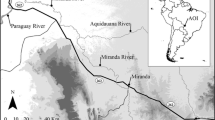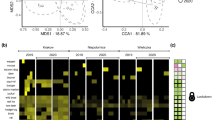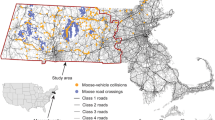Abstract
Road ecology research has tended to focus on wildlife-vehicle collisions (WVCs) while omitting or failing to differentiate domestic (i.e., livestock) animal-vehicle collisions (DAVCs). This has limited our understanding of where, when, and how frequently DAVCs occur, and whether these patterns differ from those for WVCs. We used a 10-year collision data set for the U.S. state of Montana to compare temporal and spatial patterns of DAVCs versus WVCs at multiple scales. WVCs exhibited two diel peaks (dawn and dusk) versus only one prominent peak (late evening/early night) for DAVCs. Seasonal patterns of WVCs and DAVCs were broadly similar, but DAVCs exhibited a more pronounced late-fall peak. At the county scale, DAVCs were overrepresented relative to WVCs in most of eastern Montana and underrepresented in most of western Montana. WVC and DAVC hotpots did not show strong overlap at the 1-mile road segment scale. Our results suggest that DAVCs warrant greater attention, and they may represent a high priority for management and mitigation measures in some areas because (1) they can be locally common even when regionally rare, (2) they are more dangerous to motorists on a per-collision basis than WVCs, and (3) they can present a legal liability for livestock owners. Mitigation measures for DAVCs may differ from those for WVCs and require further development and testing. Future data collection efforts should include information not only on the location and timing of animal-vehicle collisions, but also on the species of animals killed.






Similar content being viewed by others
Notes
An animal unit month is the amount of forage required by one “animal unit” (AU) for 1 month. An AU is defined as one 1000-lb mature cow, or the equivalent number of individuals of another domestic species in terms of grazing demand (e.g., 5 sheep or 0.8 horses).
Although many states in the western U.S. have large populations of both domestic horses and wild or feral horses, horses in Montana are almost exclusively domestic animals and are classified as such in collision records.
Certain exceptions exist for state highways that are part of the national system of interstate and defense highways or part of the federal-aid primary system (Mont. Code Ann. § 27-1-724 [2001]).
References
Abu Abdo A, Al-Ojaili A (2015) Assessment of awareness of livestock-vehicle traffic accidents in Dhofar region, Oman. Int J Appl Eng Res 10:38955–38959
Ager A, Johnson B, Kern J, Kie J (2003) Daily and seasonal movements and habitat use by female Rocky Mountain elk and mule deer. J Mammal 84:1076–1088
Al-Dulaimi M (2015) A method to calibrate roadway lighting warrants and levels with crash-history. Dissertation, Concordia University
Andresen MA (2009) Testing for similarity in area-based spatial patterns: a nonparametric Monte Carlo approach. Appl Geogr 29:333–345
Archer R (2002) Searching for the Montana open range: a judicial and legislative struggle to balance tradition and modernization in an evolving west. Mont Law Rev 63:1–32
Arnold G, Dudzinski M (1978) Ethology of free-ranging domestic animals. Elsevier, Amsterdam
Baddeley A, Rubak E, Turner R (2015) Spatial point patterns: methodology and applications with. R. Chapman and Hall/CRC, New York, NY
Beier P, McCullough D (1990) Factors influencing white-tailed deer activity patterns and habitat use. Wildl Monogr 109:3–51
Bissonette J, Kassar C, Cook J (2008) Assessment of costs associated with deer–vehicle collisions: human death and injury, vehicle damage, and deer loss. Human-Wildlife Conflicts 2:17–27
BLM (2018) Public land statistics 2017. U.S. Dept. of the Interior Bureau of Land Management, Denver, CO
Brazda A (1953) Elk migration patterns, and some of the factors affecting movements in the Gallatin River drainage, Montana. J Wildl Manag 17:9–23
Burton M, Prozzi J, Buddhavarapu P (2014) Predicting animal-vehicle collisions for mitigation in Texas. In: Proceedings of the International Safer Roads Conference, Cheltenham, UK
Clevenger A, Huijser M (2011) Wildlife crossing structure handbook: design and evaluation in North America. Western Transportation Institute, Bozeman, MT
Cramer P, McGinty C (2018) Prioritization of wildlife-vehicle conflict in Nevada. Nevada Department of Transportation, Carson City, NV
Dulac J (2013) Global land transport infrastructure requirements: estimating road and railway infrastructure capacity and costs to 2050. International Energy Agency, Paris, France
Farrell M, Tappe P (2007) County-level factors contributing to deer–vehicle collisions in Arkansas. J Wildl Manag 71:2727–2731
Find’o S, Skuban M, Kajba M et al. (2019) Identifying attributes associated with brown bear (Ursus actos) road-crossing and roadkill sites. Can J Zool 97:156–164
Forman R, Sperling D, Bissonette J et al. (2003) Road ecology: science and solutions. Island Press, Washington, DC
Georgii B (1981) Activity patterns of female red deer (Cervus elaphus L.) in the Alps. Oecologia 49:127–136
Green R, Bear G (1990) Seasonal cycles and daily activity patterns of Rocky Mountain elk. J Wildl Manag 54:272–279
Grilo C, Coimbra MR, Cerqueira RC et al. (2018) Brazil road-kill: a data set of wildlife terrestrial vertebrate road-kills. Ecology 99:2625–2625
Haikonen H, Summala H (2001) Deer-vehicle crashes: extensive peak at 1 hour after sunset. Am J Prev Med 21:209–213
Hallenbeck M, Rice M, Smith B et al. (1997) Vehicle volume distributions by classification. Report FHWA-PL-97-025. Washington State Transportation Center, Seattle, WA
Huijser M, Duffield J, Clevenger A et al. (2009) Cost–benefit analyses of mitigation measures aimed at reducing collisions with large ungulates in the United States and Canada: a decision support tool. Ecol Soc 14:15
Huijser M, McGowen P, Fuller J et al. (2008) Wildlife-vehicle collision reduction study: report to Congress. Western Transportation Institute, Bozeman, MT
Huuhtanen M (2016) Glowing antlers failed, so Finns try app to save reindeer. https://phys.org/news/2016-06-reindeer-herders-finland-app-road.html. Accessed 3 Apr 2019
Inbar M, Shanas U, Izhaki I (2002) Characterization of road accidents in Israel involving large mammals. Isr J Zool 48:197–206
Jeganathan P, Mudappa D, Ananda Kumar M, Shanker Raman T (2018) Seasonal variation in wildlife roadkills in plantations and tropical rainforest in the Anamalai Hills, Western Ghats, India. Curr Sci 114:619–626
Joyce T, Mahoney S (2001) Spatial and temporal distributions of moose-vehicle collisions in Newfoundland. Wildl Soc Bull 29:281–291
Kim C, Park Y, Sang S (2008) Spatial and temporal analysis of urban traffic volume. In: ESRI International User Conference, San Diego, CA
Lagos L, Picos J, Valero E (2012) Temporal pattern of wild ungulate-related traffic accidents in northwest Spain. Eur J Wildl Res 58:661–668
Lamm R, Kloeckner J, Choueiri E (1985) Freeway lighting and traffic safety—a long-term investigation. Transp Res Rec 1027:57–63
Langley R, Higgins S, Herrin K (2006) Risk factors associated with fatal animal-vehicle collisions in the United States, 1995–2004. Wilderness Environ Med 17:229–239
Laurance WF, Clements GR, Sloan S et al. (2014) A global strategy for road building. Nature 513:229–232
Lund U, Agostinelli C (2017) R package ‘circular’: Circular Statistics (version 0.4-93). https://r-forge.r-project.org/projects/circular/
Mardia K, Jupp P (2000) Distributions on spheres. In: Directional statistics. John Wiley & Sons Ltd., Chichester, England, 898:159–192
McClure M, Ament R (2014) Where people and wildlife intersect: prioritizing mitigation of road impacts on wildlife connectivity. Center for Large Landscape Conservation, Bozeman, MT
Montana DNRC (2018) Annual report for fiscal year 2018. Montana Department of Natural Resources and Conservation, Helena, MT
Montana FWP (1999) Montana elk winter ranges, summer ranges, calving areas, and migration areas. Montana Fish, Widlife and Parks, Helena, MT
Mosley J (2011) Livestock fence laws: in versus out. In: Big sky small acres: rural living in Montana magazine, vol 5. Montana State University Extension, Bozeman, MT, p 12–13
Paige C (2008) A landowner’s guide to wildlife friendly fences. Montana Fish, Wildlife and Parks, Helena, MT
Peek J, Lovaas A (1968) Differential distribution of elk by sex and age on the Gallatin winter range, Montana. J Wildl Manag 32:553–557
Perrin J, Disegni R (2003) Animal-vehicle accident analysis. Report No. UT-03.31. Utah Department of Transportation Research and Development Division, Salt Lake City, UT
R Development Core Team (2017) R: a language and environment for statistical computing. R Foundation for Statistical Computing, Vienna, Austria
Sommer E (2017) Montana annual bulletin. Montana Department of Agriculture, Helena, Montana
Spellerberg I (1998) Ecological effects of roads and traffic: a literature review. Glob Ecol Biogeogr 7:317–333
Steiner W, Leisch F, Hackländer K (2014) A review on the temporal pattern of deer–vehicle accidents: impact of seasonal, diurnal and lunar effects in cervids. Accid Anal Prev 66:168–181
Stott J, Stephenson M, Hanford K (2018) Effects of movement and activity behavior in a pasture system compared to time. Neb Beef Cattle Rep 955:72–74
Sullivan JM (2011) Trends and characteristics of animal-vehicle collisions in the United States. J Saf Res 42:9–16
Teixeira F, Kindel A, Hartz S et al. (2017) When road‐kill hotspots do not indicate the best sites for road‐kill mitigation. J Appl Ecol 54:1544–1551
Teixeira FZ, Coelho IP, Esperandio IB et al. (2013) Are road-kill hotspots coincident among different vertebrate groups? Oecologia Aust 17:36–47
USDA-APHIS (2016) Equine 2015: baseline reference of equine health and management in the United States, 2015. U.S. Department of Agriculture Animal and Plant Health Inspection Service, Fort Collins, CO
USFS (2016) FY2015grazing statistical summary. U.S. Department of Agriculture Forest Service Rangelands Management Program, Washington, DC
van der Grift EA, van der Ree R, Fahrig L et al. (2013) Evaluating the effectiveness of road mitigation measures. Biodivers Conserv 22:425–448
Van der Ree R, Smith D, Grilo C (2015) Handbook of road ecology. John Wiley & Sons, New York, NY
Van Rees H, Hutson G (1983) The behaviour of free-ranging cattle on an alpine range in Australia. J Range Manag 36:740–743
Wanvik P (2009) Effects of road lighting: an analysis based on Dutch accident statistics 1987–2006. Accid Anal Prev 41:123–128
Wildlife Quality Improvement Team (2005) Wildlife and domestic animal-vehicle collisions. Utah Department of Transportation, Taylorsville, Utah
Zaloshnja E, Miller T, Galbraith M et al. (2003) Reducing injuries among Native Americans: five cost-outcome analyses. Accid Anal Prev 35:631–639
Zeller KA, Wattles DW, DeStefano S (2018) Incorporating road crossing data into vehicle collision risk models for moose (Alces americanus) in Massachusetts, USA. Environ Manag 62:518–528
Acknowledgements
Montana Department of Transportation provided collision data for this study. In-kind support was provided by the Center for Large Landscape Conservation and Western Transportation Institute.
Author information
Authors and Affiliations
Corresponding author
Ethics declarations
Conflict of Interest
The authors declare that they have no conflict of interest.
Additional information
Publisher’s note Springer Nature remains neutral with regard to jurisdictional claims in published maps and institutional affiliations.
Supplementary Information
Rights and permissions
About this article
Cite this article
Creech, T.G., Fairbank, E.R., Clevenger, A.P. et al. Differences in Spatiotemporal Patterns of Vehicle Collisions with Wildlife and Livestock. Environmental Management 64, 736–745 (2019). https://doi.org/10.1007/s00267-019-01221-3
Received:
Accepted:
Published:
Issue Date:
DOI: https://doi.org/10.1007/s00267-019-01221-3




